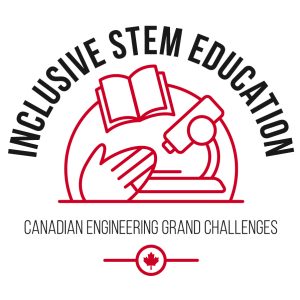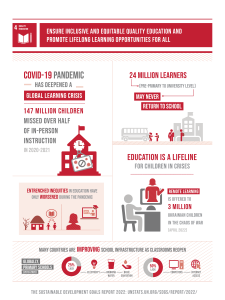CEGC 6: Access to Affordable and Inclusive STEM Education

Connection to the United Nations Sustainable Development Goals
| Education creates opportunities for people to rise above poverty | Inclusive STEM education aims to eradicate the gender gap in STEM careers | ||
| Education helps to provide for the good health and well-being of those who have it | Inclusive STEM education’s goal is to reduce inequalities in education availability and quality | ||
| Inclusive STEM education will increase quality of education programs as a whole | Betterment of STEM education increases people’s knowledge of how to counteract climate change |
What is the Canadian Engineering Grand Challenge Statement?
The challenge for inclusive STEM education is to ensure the role engineers play in society is well understood and that engineering becomes an affordable, accessible and welcoming destination and profession of choice for all students who are interested in it (EDC-DDIC, 2022).
High Level Overview of the Canadian Engineering Grand Challenge
In the 19th century, Horace Mann famously dubbed education “the great equalizer of the conditions of men”. While the veracity of that statement has been debated over time, the fact of the matter is that education creates opportunities and possibilities that would have been otherwise out of reach. These opportunities in engineering are currently in the hands of predominantly male students. As of December 2020, only a fifth of newly licensed engineers identified as female. Not only women, but Indigenous people are also underrepresented in engineering. Lack of representation in the workplace can make it more challenging for young engineers of minority groups to engage with and reach their full potential in their careers. As instructors, it is important to understand and acknowledge the barriers that students might be facing and do what we can to help them overcome them. In order to bridge these gaps and make engineering a profession for all, Canadian engineering education programs of all levels need to become more approachable and inclusive as we move into the future.
Example Connection to a Sustainable Development Goal
CEGC 6: Access to Affordable and Inclusive STEM Education maps to several Sustainable Development Goals, where an example of one of the connections is to SDG 4 – Quality Education, which has a goal to “Ensure inclusive and equitable quality education and promote lifelong learning opportunities for all” (United Nations, 2023).
Figure: Infographic on Sustainable Development Goal 4 (United Nations, 2023)
Keywords: diversity, implicit bias, multi-disciplinary learning, accessibility, higher education enrollment, affordability
Status of the Challenge Globally
Education is a valuable opportunity that is not enjoyed equally by all people throughout the world. People in low-income countries are significantly less likely to get a higher education than those in middle or high-income countries. STEM education, and even more so with engineering, is still a male-dominated discipline.
Status of the Challenge in Canada
Across engineering disciplines in Canadian universities, there are large differences in the participation of women with programs such as environmental and biomedical/biological being close to parity. In contrast traditional engineering disciplines such as mechanical, electrical, computer and software engineering are typically closer to 15%. A key factor related to this is that in high school, women are much less likely than men to take the required science courses (math, chemistry and physics) to ensure they are engineering ready and able to apply to study engineering at a post secondary institution. Of these required high school courses, physics has the least participation amongst men and women and the largest gender gap (Design Engineering, 2018). This is a critical issue in terms of economic growth for Canada and a recent McKinsey report (McKinsey, 2022) stated that Canada’s key inequality indicators are women in Science, Technology, Engineering and Mathematics (STEM) education and the STEM workforce of which engineering is a significant part. Another group of people who are significantly underrepresented in Canadian engineering programs are Indigenous students; while Indigenous peoples make up 4.9 per cent of the Canadian population (Statistics Canada, 2017), they only account for 1.2 per cent of total undergraduate enrolment in engineering programs (Engineers Canada, n.d.).
Roadblocks to Success
On the surface, it may seem like education is equally welcoming to all those who desire it. In reality, however, there are many different factors that could discourage a student from pursuing a career in STEM. Implicit biases can create expectations of failure for certain demographics of people who are not typically associated with engineering. These people also have potential to form self-identity perspectives that they cannot be themselves or that they don’t belong in engineering. This can be a common cause for people to leave the engineering profession altogether. The public perspective that views engineers as number-crunching robots rather than innovators and adaptive problem solvers hampers the ability of engineering programs to recruit individuals from diverse backgrounds and interests. Lack of complete information about students studying engineering also makes it challenging to understand which demographics are not being reached. Finally, education is expected to only get more expensive, and in light of the fact that governmental support of higher education is declining, access to STEM careers can be too expensive for many students.
Strategies to Meet 2030 Targets
To address the challenge of providing access to affordable and inclusive STEM education, Engineering Deans Canada have identified the following strategies (EDC-DDIC, 2022):
- Striving for broader diversity of engineering programs to include women, indigenous peoples and other underrepresented groups.
- Adopting more socially-relevant and outward-facing engineering curricula that emphasizes multidisciplinary learning and societal impact.
- Enhancing the understanding of the social psychology aspects involved for people who enter and persist in engineering programs.
- Ensuring the affordability of engineering programs in the future.
- Developing university engineering programs that are relevant to young people and are sought after by students.
References
- Design Engineering. (2018, April 4). Closing the engineering gender gap. Retrieved February 23, 2023, from https://www.design-engineering.com/features/engineering-gender-gap/
- EDC-DDIC. (2022, May 6). Canadian Engineering Grand Challenges (2020-2030). Engineering Deans Canada. Retrieved February 23, 2023, from https://engineeringdeans.ca/en/canadian-engineering-grand-challenges-2020-2030-inspiring-action-to-improve-life-for-canadians-and-the-world/
- Engineers Canada. (n.d.). Canadian Engineers for Tomorrow. Retrieved February 23, 2023, from https://engineerscanada.ca/publications/canadian-engineers-for-tomorrow-2017#total-undergraduate-student-enrolment
- McKinsey. (2022).The power of parity: Advancing Women’s equality in the United States. (n.d.). Retrieved February 23, 2023, from https://www.mckinsey.com/~/media/McKinsey/Featured%20Insights/Employment%20and%20Growth/The%20power%20of%20parity%20Advancing%20womens%20equality%20in%20the%20United%20States/MGI-Power-of-Parity-in-US-Full-report-April-2016.ashx
- United Nations (2023). The 17 Goals, United Nations Department of Economic and Social Affairs, Sustainable Development. Retrieved February 27, 2023, from https://sdgs.un.org/goals

